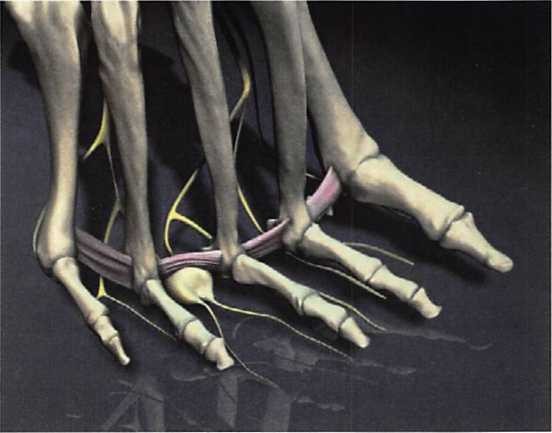What is a Morton's Neuroma?
It can be a limiting foot problem that may slow you down tremendously at times. This is an enlargement of one of your foot nerve located right behind and between two of your lesser toes. Most likely between your third and fourth toes. Your neuroma condition is a progressive thickening of the nerve envelope. Just like a callus is formed by progressive skin thickening from excessive rubbing and pressure.
What are the causes of a compression neuritis also known as Morton’s neuroma?
Repetitive nerve rubbing, compression and stretching due to overpronation, barefoot lifestyle or wearing unsupportive flimsy or high-heeled shoes are among the culprits.
How does it feel like and look like?
At the beginning, you may have the sensation of walking on a pebble. Then you may experience sharp pain, burning sensations or even a lack of feeling in the area. Your pain is usually worsened by any physical activity causing pressure on your forefoot. Your soft tissue condition will not show up on x-ray. But it will on an ultrasonic exam – which may show a concomitant bursitis compressing your nerve even more! A clinical diagnosis is made by palpation of your pain area. You may also notice an increased gap between your toes, compared to your other foot. This added space in between toes are the result of nerve enlargement. It is called “the daylight sign” since you can see light between your toes – see picture under. Moving your toes sometimes causes a clicking sensation or discrete noise as the enlarged nerve slides under the overlying ligament running in between your toe joints.

The Daylight Sign
As your nerve lump is getting bigger, it is squeezed in between the ground and the ligament running in between your toe joints. This may spread your toes apart. The daylight sign is a typical visual sign indicating the presence of a neuroma condition.
How did I get it?
When you overpronate, the arch of your foot collapses, your heel is rolling inwards as your forefoot moves outward. This causes excess force to shift onto the smaller bones of your forefoot and toes. These smaller bones are not designed to handle such an overload. The excess force soon breaks down the soft tissues, including the nerves running down to the toes. As the nerve thickens to protect itself, it occupies more space and is more easily rubbed. Eventually, the nerve gets so big that it is sensitive to every step. And pain can even spread down to toes. Shoe wear that is too tight in the toe area, high heels that place additional pressure on your forefoot, and an increase in physical activity are also thought to exacerbate the pain of a Morton’s Neuroma.
The Pain of Walking on Your Nerve Lump
At the end of each step out of your way, you rise your heel off the ground to push your body forward. Then your nerve lump is heavily compressed against the ground by your body weight and by the overlying ligament.

What are the Best Options in my Specific Neuroma Condition?
Helping your nerve lump to heal and shrink back to its normal size is our goal. It is important to note that, as with most conditions, attacking the problem early enough is critical to avoid the need for surgery. Should surgery be necessary, use of orthotics before and after surgery will help insure greater success. With a proper diagnosis and treatment plan, your chances of success are excellent. As with most foot problems we always suggest conservative options first, often recommended and dispensed in combination for optimal results.
1. Custom-made Foot Orthotics fitted into Prescription Stylish or Orthopedic Shoes.
Custom-made orthotics and prescription shoes will correct any foot dysfunction overloading your enlarged and ailing foot nerve. They are designed to restore proper weight distribution down to your toes whenever standing and walking. More load will be transferred over the big toe. The goal is to offload the lesser toes and to remove the abnormal pressures causing your nerve to thicken.
2. Laser Pain & Regenerative Therapy.
A series 4 to 6 laser treatment will significantly reduce pain and inflammation. Lots of light energy will be absorbed by your ailing and damaged cells. This new energy will be used to initiate and sustain faster and better healing.
3. Injection.
Your condition may not respond to the above first-line treatments. This very unlikely since most of our patients get rid of their condition within one to three months wearing custom-made orthotics fitted into supportive prescription shoes. We combine or add 4 sessions of laser pain therapy in severe long-lasting conditions.
If need be, cortisone can be injected into the area to reduce swelling and pain. Shrinkage of the nerve can also be achieved with a series of alcohol injections.

